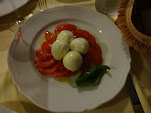Our final visits in and around Viljoenskroon included two farms and two schools. The schools one rural and one in town were as different as black and white.
.
Niekerksrus Landbouskool, a few kilos outside of Viljoenskroon, is a high school (grades 8 – 12) originally founded as an agricultural school We met with headmaster Klasie Dewet (“the Law”), a rotund white man with a strong dedication to the students and their school .
.
The original idea of the agricultural schools was to draw children from the rural areas and prepare them for work in their communities. However, the emphasis has shifted to a more general education as enrollment is down. Smaller farms have been bought up and consolidated; technology has decreased the number of laborers needed. Feeder schools are closing. People have moved away. The learners are 70% Sesotho, 30% Zulu and Xhosa. All students are Afrikaans speaking, but English is taught as it is the language of business and commerce.
.
Qualified educators (teachers) are not readily available to work here in the rural area. The students are generally not proficient at grade level. Bureaucratic requisition requirements causes difficulty accessing money for the simplest of repairs.
.
Solomon Senekal Hoerskool, the public high school in Viljoenskroon, is more typical of a successful, yet cash strapped school. The national government pays the salaries of the teachers and funds the school at a rate of R700 ($100) per learner per year. However, each student is expected to pay an annual school fee - if possible. No one will be denied admission for want of payment. Here, the annual fee is R1250 ($180) per school year. This is supposed to cover general maintenance, textbooks - all expenses really, other than the salaries of the staff.
.
The student body is 99% white. All students wear uniforms, with the boys wearing shorts. Many of the younger boys go barefoot by choice. Watching the young barefoot boys walk across the hard nut-like seed on the asphalt causes me to wince.
The farms we visited were examples of strong family ties and the application of high technology. The JK von Biljon farm, for example boasts champion, as in national Champion, ram and bull. The latest husbandry information and veterinary science is applied. We also made a quick stop at the farm of Mr. Meintjes and his son, JP (whom Annie Rose took a liking to). The farm, Kruispan, cultivates some 3,000 hectares in maize and another 1,200 are allotted for grazing.
.
The cleanliness and orderliness of Kruispan is difficult to describe. No implement, tractor or tools is put away unless totally and completely clean. No dirt. All are stored in neat rows. We’re talking dozens of tractors. I saw one farm hand taking a break while his spreader was loaded with nitrogen – he was polishing the tractor, in the field!
.
Next stop Welkom – or “Vell-comm” as Annie Rose likes to say.
Saturday, September 15, 2007
Subscribe to:
Post Comments (Atom)

No comments:
Post a Comment